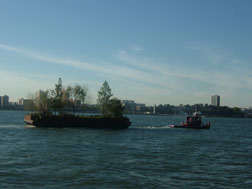
 |
 An image from our trip to NYC to see the Smithson Floating Island  |
Islands in the Art World and other constructed islands Robert Smithson's Floating Island to Travel Around Manhattan The Living Barge project is visually closest to an art piece conceived in 1970 by landscape artist Robert Smithson. Smithson proposed the creation of a park on top of a barge that would circumnavigate Manhattan. This proposal, titled "Floating Island to Travel around Manhattan" was intended to play off the idea of Central Park as an island in the city. As part of a retrospective for Smithson at the Whitney Museum in 2005, Floating Island was realized - thirty years after Smithson's death. While we didn't know about Floating Island until the Living Barge Project was well underway, the Living Barge Project has, more than ever, become a tribute to Smithson and his ideas. An icon in the environmental arts movement, Smithson found the gallery and the museum to be too intertwined with an elitist, capitalist paradigm. His earthworks were not only set outdoors, but they directly related to, or commented on, their surroundings. More like the great pyramids in Egypt or Mexico than a piece of outdoor sculpture, Smithson's large earthworks are ceremonial in nature and were not meant to be bought, sold, or transported from museum to museum. Smithson also wanted to interact with new audiences in the construction and display of his work. These principles are something many artists - including Smithson - struggle with. How can we make art that is not just a commodity? How can we bring our art to a wider audience? Is it possible to use art not just as social commentary or propaganda, but something that more actively affects change? Given our own experiences in urban planning and community-based action, our approach was to take tools from these realms and integrate them with the Living Barge Project. We believe that art can respond uniquely to the community in which it is placed and can also be a platform to discuss ideas and examine particular issues in a unique forum. It creates something of which the community is proud, and increases the capabilities of those who see it to think big and envision what they want their community to be. More Floating Island Links: One of the nicest photos of the Smithson barge - and an answer to a question we've been wondering for a long time. Mark Stevens' New York magazine article A lengthy and thorough article on Floating Island and the Smithson retrospective at the Whitney, by John Haber.
Other Constructed Islands and
Art About Islands |
HOME/FAQ SCHEDULE MAP / DIRECTIONS CONSTRUCTION JOURNAL PHOTOS PARTNERS DONORS THE ARTISTS ART& ISLANDS THE DUWAMISH VOLUNTEER/DONATE |